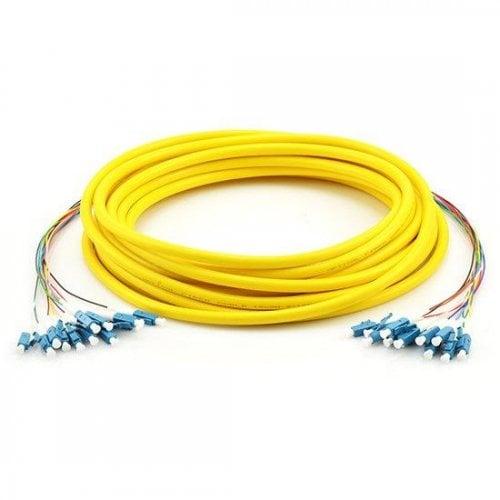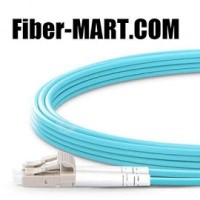Ribbon Fiber Optic Cable vs. Single-Core Fiber Optic Cable

With the rapid advancement of communication technology, fiber optic cables have become the backbone of modern data transmission. Among the diverse types of fiber optic cables, ribbon fiber optic cable and single-core fiber optic cable are two of the most common choices. As a professional ribbon fiber optic cable manufacturer, Fibermart is excited to provide you with an in-depth look at the differences between these two types of cables and their respective advantages and disadvantages, helping you make an informed choice.
Ribbon Fiber Optic Cable vs. Single-Core Fiber Optic Cable
In this article, we’ll discuss the structure, transmission efficiency, ease of installation, maintenance needs, cost, and application scenarios for both ribbon fiber optic and single-core fiber optic cables, giving you a clear understanding of their unique strengths and limitations.
Ⅰ. What are Ribbon Fiber Optic Cable and Single-Core Fiber Optic Cable?
Before we dive into the advantages and disadvantages, let’s start with a brief overview of ribbon fiber optic cable and single-core fiber optic cable.

1.Ribbon Fiber Optic Cable:
Ribbon fiber optic cables consist of multiple fiber cores arranged in parallel and bonded together in a “ribbon-like” structure. Typically available in configurations of 12, 24, or more fibers, they allow high-density fiber placement within a compact space, making them ideal for applications requiring multiple fibers.
2.Single-Core Fiber Optic Cable:
As the name suggests, single-core fiber optic cable includes only one fiber core. It has a simpler structure and is often used for smaller, single data transmission needs, especially in applications where shorter distances or lower data volume suffice.
Ⅱ. Advantages and Disadvantages of Ribbon Fiber Optic Cable
As a high-density data transmission solution, ribbon fiber optic cable offers several clear advantages but also has a few limitations.
1. Advantages
(a) High Density and Space-Saving
Ribbon fiber optic cable can accommodate multiple fibers in a single cable, enabling higher fiber density within a limited space. This feature makes ribbon fiber optic cable especially suitable for data centers, 5G base stations, and densely cabled buildings. Compared to single-core fiber optic cables, ribbon fiber optic cables help save installation space and reduce cabling complexity.
(b) Efficient Mass Fusion Splicing and Installation
The parallel arrangement in ribbon fiber optic cables allows for efficient fusion splicing. Technicians can splice 12 or 24 fibers simultaneously, significantly boosting work efficiency. Additionally, the structured arrangement simplifies fiber alignment and matching, making installation quicker for large-scale projects. This convenience makes ribbon cables an ideal choice when you want to buy ribbon fiber optic cable for high-density, high-efficiency installations.

(c) Ideal for High Bandwidth and Long-Distance Transmission
Ribbon fiber optic cables are designed to support high-bandwidth and long-distance transmissions. The more fibers within a cable, the greater its data transmission capacity. In high-density environments like data centers and large-scale communication networks, ribbon fiber optic cables easily meet the demands for high-speed data transmission.
2. Disadvantages
(a) Higher Cost
Ribbon fiber optic cable requires a more complex manufacturing process, and the higher fiber count increases production costs. For projects with limited budgets, this cost may be a deciding factor, particularly if large quantities are required.
(b) More Complex Maintenance and Repair
Due to their tightly packed structure, ribbon fiber optic cables can be more challenging to troubleshoot and repair. If a single fiber fails, it may impact the entire ribbon. Repairing these cables usually requires specialized equipment and expertise, which can increase maintenance costs.
Ⅲ. Advantages and Disadvantages of Single-Core Fiber Optic Cable
Single-core fiber optic cables are the more traditional choice in fiber optic cabling, with several distinct advantages and disadvantages, making them suitable for specific use cases.
1. Advantages
(a) Lower Cost
With a simple structure, single-core fiber optic cables have lower production costs. This makes them a budget-friendly choice for smaller projects or applications with shorter transmission distances.

(b) Easier Maintenance and Repair
Single-core fiber optic cables are straightforward in structure, so it’s easier to identify and fix issues when they arise. With only one fiber, technicians can quickly diagnose and replace faulty sections, saving both time and repair costs.
(c) Suitable for Short-Distance Data Transmission
Single-core fiber optic cable performs well in short-distance data transmission, making it an ideal solution for small local area networks, home wiring, and office buildings where simpler cabling meets the data transfer requirements.
2. Disadvantages
(a) Lower Transmission Density
The single-core design limits the transmission density, making single-core fiber optic cable unsuitable for high-fiber-density environments. In settings like data centers or 5G base stations, a high volume of single-core fiber optic cables would be required to match the capacity of ribbon fiber optic cable, leading to space and cable management challenges.
(b) Lower Installation Efficiency
Compared to ribbon fiber optic cables, single-core fiber optic cables are less efficient to install. Each fiber must be individually spliced, increasing both time and labor costs, especially in large-scale projects where rapid deployment is essential.
(c) Unsuitable for High Bandwidth and Long-Distance Needs
Single-core fiber optic cable generally does not meet the requirements of high-bandwidth and long-distance transmissions. For projects requiring high-speed, long-distance data transfer, single-core cables may not perform adequately.
Ⅳ. Comparing Application Scenarios for Ribbon and Single-Core Fiber Optic Cables
Based on their distinct characteristics, here’s how ribbon fiber optic and single-core fiber optic cables fit into different application scenarios:
1.Ribbon Fiber Optic Cable:
Ribbon fiber optic cable is ideal for environments that require high-density fiber installations, such as data centers, 5G base stations, intelligent buildings, and large-scale network infrastructure. This cable type meets the high standards of bandwidth, transmission speed, and installation efficiency demanded by these scenarios.
2.Single-Core Fiber Optic Cable:
Single-core fiber optic cable suits small LANs, home networks, and partial connections in office buildings, where short-distance and low-density data needs are common. It is a cost-effective solution for data transmission in simpler settings.

Ⅴ. How to Choose the Right Fiber Optic Cable for Your Project
Selecting the right fiber optic cable based on your project’s needs is key to network stability and cost control. Here are some helpful considerations:
1.Project Scale:
For large-scale, high-density installations, ribbon fiber optic cable is a better fit. For small projects or home networking, single-core fiber optic cable is more economical.
2.Transmission
Distance and Bandwidth Needs: If your project requires high bandwidth and long-distance transmission, ribbon fiber optic cable will deliver optimal performance. For short-distance transmission, single-core fiber optic cable will help you control costs while meeting performance needs.
3.Installation and Maintenance Costs:
Ribbon fiber optic cable offers higher installation efficiency but may require specialized maintenance. For applications with frequent maintenance requirements, single-core fiber optic cable may be easier to manage.
4.Budget Considerations:
Ribbon fiber optic cable generally costs more, making it suitable for well-funded projects. For those with limited budgets, single-core fiber optic cable offers a cost-effective solution without sacrificing reliability.
Ⅵ. Conclusion
Overall, ribbon fiber optic cable and single-core fiber optic cable each offer unique advantages and fit specific application scenarios. As a dedicated ribbon fiber optic cable manufacturer, Fiber-Mart focus on delivering high-quality, high-performance ribbon fiber optic cables to meet the demands of modern communications for high density and high-speed data transmission. By choosing the right cable, you can optimize your network architecture for reliable, long-term performance. We hope this detailed comparison helps you better understand these two types of fiber optic cables, enabling you to choose the best solution for your project.
Post Your Ad Here

Comments